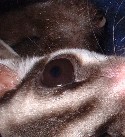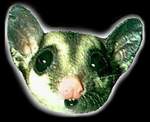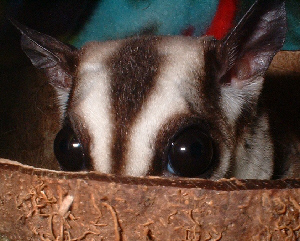Those big beautiful deep dark brown eyes...who can resist their bug-eyed look!
Alot of people think their eyes are solid black... in fact, the Pupil (center) is black, and the Ring of Color around the Pupil is a deep dark brown.
Unless the glider is of course an Albino, they have 'different' eyes.
(Gliders have avascular retinae, with only a small residual tuft of fluoresceinimpermeable vessels projecting from the optic disc into the vitreous, suggesting superior night vision - meaning their eyes are set up to see very well at night).
A sugar glider’s big eyes, like the big bad wolf’s in Red Riding Hood, are better to see you (or tiny bugs and such) with! Being nocturnal creatures, the eyes are enlarged for good reason. It enables them to see in the dark better, which is when they feed and play most, and are safest from predators in the wild.
The structures within the glider’s eye that enable them to see well at night are connected to form almost a complete layer within the eyeball, lying underneath the white layer of the eye. The choroid covers the inside of the eye from the opening in the back where the optic nerve enters the eyeball to the outer edge of the iris. The choroid’s function is nourishment of the eye, and to aid in light absorption which helps visual accuracy. The choroid is continuous with the ciliary body, which is located at the iris’s edge. The ciliary body controls lens shape, and holds the lens of the eye in proper position which is also very important to proper vision. The ciliary body is continuous with the iris. The iris, the colored portion of the eyeball in sugar gliders ( those brownish-black peepers that look lovingly at you every time you offer mealie worms - wait, was that loving look meant for the mealie?) allows or restricts light into the eye, as necessary for vision by means of the pupil. If you imagine a ping pong ball with holes in opposite sides, coated on the inside with chocolate (except for the holes!), you are on the right track.
By the way, the structure of a sugar glider’s eye, and a human’s are almost the same. With the exception of the number of Rods and Cones (whats responsible for color viewing), and in many nocturnal/semi nocturnal animals, but not man, a very shiny part of the choroid called the Tapetum Lucidum allows some of the light to re-stimulate the retina. (With the help of a white mirror like substance called Guanine, light passes back and forth through the retina twice, essentially doubling the light, thus allowing those animals to see better in dim light.) The bounce back of the Tapetum Lucidum is what appears as the 'eye shine' or 'evil eye' look (especially in photos).
What does this all mean?!
If you stay out late at night and prowl everynight, you too will get bug-eyed… Hehe! ;-)
It is thought that Gliders see the color red, and everything else is in shades of black and white similar to an old movie.
The reason Gliders see only the color red, is due to the number of cones in the eye that make up what
colors are seen and whats not. The rods are what are responsible for the blacks and whites... the cones...
they come in three varieties... red, blue, and green. From what I understand, Gliders only have the cones responsible
for seeing reds. The ability to see colors is relatively rare among vertebrates. Humans and other primates see in color,
but most other mammals do not....some animals can see some colors but not all colors.
*New info (2005): Its now suggested through one study in Western Australia, that Marsupials CAN see in color. It is suspected that ALL marsupials can see in color somewhat, from close microscopic looks at the cone cells at the top of the retina and the rear of the eyes of two different marsupial species.
*Keep in mind this is one study, and they havent taken a look at a Sugar Glider specifically, it is assumed from the study of just these two specimens, that all marsupials see in color somewhat.
* Eyes should always be bright, sparkly, and clear....There should never really be a discharge or they shouldnt look dull or cloudy.
If you notice any change in their eyes...have a vet check it out.
Click on a photo to enlarge...
Eyes...







